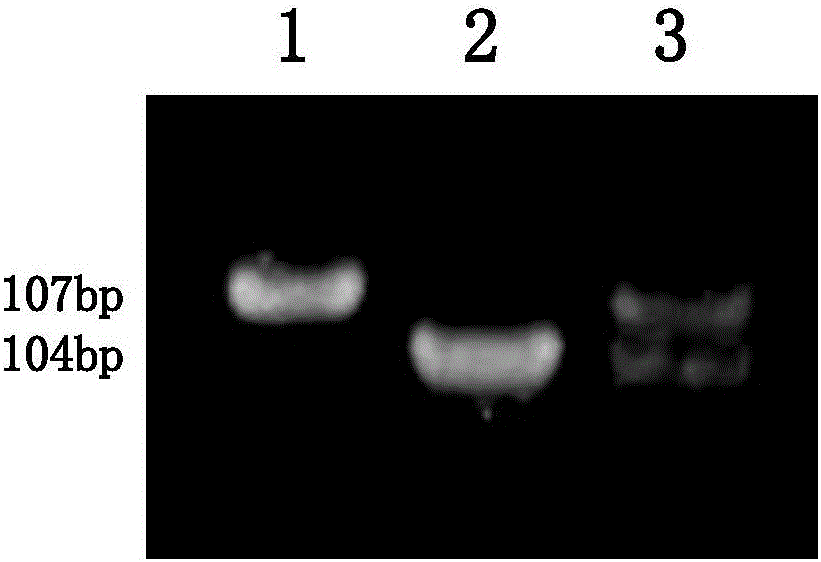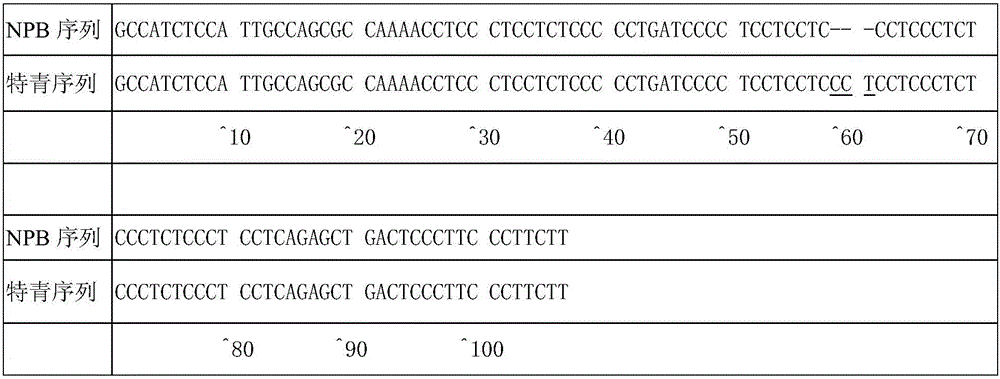Molecular marker for rice amylose content micro-control genes SSIII-1 and application of molecular marker
A technology of amylose content and molecular markers, applied in the field of agricultural biotechnology engineering, can solve problems such as poor accuracy, and achieve the effect of overcoming long time periods and reducing amylose content
- Summary
- Abstract
- Description
- Claims
- Application Information
AI Technical Summary
Problems solved by technology
Method used
Image
Examples
Embodiment 1
[0061] Example 1. Using the Indel marker SSIII-1-m to identify polymorphisms in the japonica rice Nipponbare with low amylose content and the indica rice Teqing with high amylose content
[0062] The specific method is as follows: select rice materials Nipponbare and Teqing, use Nipponbare and Teqing to cross to obtain its F1, and use primer SSIII-1-m to identify its polymorphism ( figure 1 ).
[0063] 1. DNA extraction
[0064] 1) Prepare DNA extraction buffer:
[0065] Add 1 volume of DNA extraction solution (0.35Msorbitol; 0.1MTris, pH8.2; 0.005MEDTA; the rest is water), 1 volume of nuclear lysis solution (0.2MTris, pH7.5; 0.05MEDTA; 2MNaCl; 0.055MCTAB) in sequence ; the rest are water) and 0.4 volumes of 5% (mass concentration) sarkosyl solution (i.e. the aqueous solution of sodium lauryl-N-methylglycinate); finally add sodium bisulfite to be mixed with DNA extraction buffer; bisulfite The final concentration of sodium in DNA extraction buffer was 0.02M.
[0066] The p...
Embodiment 2
[0085] Example 2. Using the Indel molecular marker SSIII-1-m to identify sequence differences between the japonica rice Nipponbare with low amylose content and the indica rice Teqing with high amylose content
[0086] The specific method is: use the Indel molecular marker SSIII-1-m to perform PCR amplification on the genomic DNA of Nipponbare and Teqing, entrust Shanghai Yingjun Biotechnology Co., Ltd. to sequence the amplified products, and compare the differences in their sequences ( figure 2 ).
[0087] 1. DNA extraction
[0088] 1) Prepare DNA extraction buffer:
[0089] With embodiment 1.
[0090] 2), the paddy rice blade of above-mentioned Nipponbare and special green is carried out as follows respectively:
[0091] With embodiment 1.
[0092] 3) PCR amplification
[0093] With embodiment 1.
[0094] 4) Recovery of PCR products
[0095] The recovery of PCR products was carried out by using the PCR product recovery kit (spin column type, catalog number: DP1403) de...
Embodiment 3
[0097] Example 3. Using the Indel marker SSIII-1-m to carry out assisted selection breeding for low amylose content
[0098] The specific method is: the gene donor parent Nipponbare with low amylose content, and the indica rice variety Teqing with high amylose content are sequentially crossed, backcrossed and selfed, and the resulting progeny are combined with the assisted selection of the molecular marker SSIII-1-m, A single plant with the same band type as Japan Sunshine in the segregation population was selected for breeding improvement.
[0099] 1. DNA extraction
[0100] 1) Prepare DNA extraction buffer:
[0101] With embodiment 1.
[0102] 2), above-mentioned Nipponbare, Teqing, and the rice blades of the gained offspring are respectively processed as follows:
[0103] With embodiment 1.
[0104] 2. Indel marker detection
[0105] 1), PCR amplification
[0106] With embodiment 1.
[0107] 2), electrophoresis detection
[0108] With embodiment 1.
[0109] 3. Inde...
PUM
 Login to View More
Login to View More Abstract
Description
Claims
Application Information
 Login to View More
Login to View More - Generate Ideas
- Intellectual Property
- Life Sciences
- Materials
- Tech Scout
- Unparalleled Data Quality
- Higher Quality Content
- 60% Fewer Hallucinations
Browse by: Latest US Patents, China's latest patents, Technical Efficacy Thesaurus, Application Domain, Technology Topic, Popular Technical Reports.
© 2025 PatSnap. All rights reserved.Legal|Privacy policy|Modern Slavery Act Transparency Statement|Sitemap|About US| Contact US: help@patsnap.com



